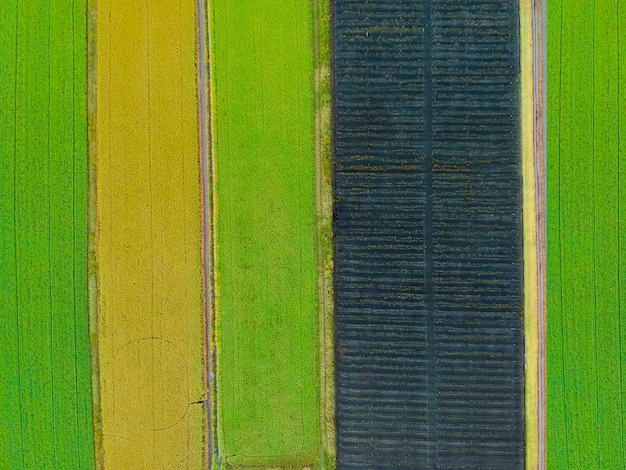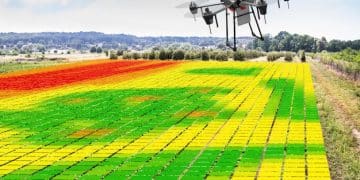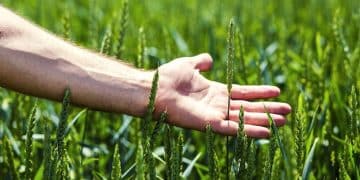Crop Rotation: Enhancing Soil Fertility for Sustainable Agriculture

Sustainable agriculture leverages crop rotation to improve soil structure, nutrient availability, and pest control, ensuring long-term soil fertility and environmental health.
In the realm of sustainable agriculture: understanding the impact of crop rotation on long-term soil fertility is paramount. Crop rotation, a time-tested farming practice, offers a pathway to healthier soils, reduced reliance on synthetic inputs, and increased agricultural resilience.
Understanding the Basics of Crop Rotation
Crop rotation is more than just changing crops in a field; it’s a strategic approach to managing soil health and productivity. This practice involves planning a sequence of different crops to be planted in the same field over multiple seasons or years.
By carefully selecting crop sequences, farmers can harness the beneficial interactions between different plant species and the soil ecosystem. This leads to improved soil structure, nutrient cycling, and pest and disease management.
Benefits of Crop Rotation
Crop rotation offers a multitude of benefits that contribute to long-term soil fertility and sustainable agricultural practices.
- Improved Soil Structure: Different crops have different root systems that can help to improve soil structure, aeration, and water infiltration.
- Enhanced Nutrient Cycling: Rotating crops with varying nutrient requirements can prevent nutrient depletion and promote a more balanced nutrient profile in the soil.
- Reduced Pest and Disease Pressure: Breaking pest and disease cycles by rotating crops can minimize the need for synthetic pesticides and promote biological control.
- Increased Biodiversity: Crop rotation supports a more diverse soil microbiome, which is essential for soil health and resilience.
In essence, crop rotation is a nature-inspired technique that maximizes the potential of the soil ecosystem for sustainable agricultural production. It’s a proactive approach that mitigates the risks associated with monoculture farming.
Crop Rotation and Soil Health
The core of sustainable agriculture lies in maintaining and enhancing soil health. Crop rotation plays a pivotal role in achieving this goal by addressing various aspects of soil fertility and overall soil quality.
Through strategic crop sequencing, farmers can revitalize depleted soils, improve their physical properties, and foster a thriving soil ecosystem.

Improving Soil Structure
Different crops have different root systems that contribute to soil structure in unique ways. For example, deep-rooted crops like alfalfa can break up compacted soil layers, while fibrous-rooted crops like grasses improve soil aggregation.
Rotating these crops can create a more porous and well-drained soil, which enhances water infiltration, reduces erosion, and creates a more favorable environment for plant growth.
Enhancing Nutrient Availability
Crop rotation can significantly improve nutrient cycling and availability in the soil. Legumes, for instance, have the ability to fix atmospheric nitrogen through a symbiotic relationship with soil bacteria.
This process enriches the soil with nitrogen, a vital nutrient for plant growth. When legumes are rotated with other crops, they can provide a natural source of nitrogen fertilizer, reducing the need for synthetic inputs.
Crop rotation is key in soil revitalization. It helps to create a resilient and fertile soil that can support long-term agricultural productivity. By focusing on soil health, farmers can reduce their reliance on synthetic fertilizers and pesticides, while also protecting the environment.
Selecting the Right Crops for Rotation
Effective crop rotation depends on carefully selecting the right crops to include in the rotation sequence. Factors such as crop type, nutrient requirements, pest susceptibility, and market demand should be considered when developing a crop rotation plan.
The overarching idea is to select crops that complement each other in terms of their impact on soil health and productivity. This can create a synergistic effect that enhances overall agricultural output.
Considerations for Crop Selection
Here are some key considerations when selecting crops for rotation:
- Crop Type: Include a mix of different crop types, such as legumes, grasses, and broadleaf crops, to promote diverse soil benefits.
- Nutrient Requirements: Rotate crops with varying nutrient requirements to prevent nutrient imbalances and minimize fertilizer inputs.
- Pest and Disease Susceptibility: Choose crops that are not susceptible to the same pests and diseases to break pest cycles and reduce disease pressure.
- Market Demand: Consider the market demand for different crops to ensure profitability and economic sustainability.

By carefully weighing these factors, farmers can design a crop rotation system that is tailored to their specific farming conditions and goals which helps to improve long-term yields.
Implementing Crop Rotation in Practice
Implementing crop rotation requires careful planning and a systematic approach. Farmers need to consider the specific characteristics of their land, climate, and crops when designing a crop rotation system.
A well-designed crop rotation plan should take into account the long-term goals of the farm, such as improving soil health, reducing pest pressure, and increasing overall productivity.
Steps for Implementing Crop Rotation
Here are the necessary steps:
- Assess the soil health, nutrient levels, and drainage characteristics of the land.
- Identify the primary pests and diseases that affect crops in the area.
- Research the nutrient requirements, growth habits, and pest susceptibility of different crops.
- Develop a crop rotation plan.
Crop rotation can be a powerful tool for enhancing sustainability and achieving long-term agricultural success. By carefully considering these practical aspects of implementation, farmers can maximize the benefits of crop rotation and create a more resilient and productive farming system.
Overcoming Challenges in Crop Rotation
While crop rotation offers multiple benefits, there are also potential challenges that farmers may encounter when implementing this practice.
These challenges can range from logistical issues to economic constraints, and it is important to address them effectively.
Common Challenges and Solutions
These include:
- Limited Equipment: Some farmers may lack the equipment needed to plant and harvest a diverse range of crops.
- Labor Requirements: Implementing crop rotation may require additional labor for planting, harvesting, and managing different crops.
- Market Access: Farmers may face limitations in accessing markets.
Overcoming these challenges requires careful planning, resourcefulness, and collaboration among farmers, researchers, and policymakers. By addressing these barriers, we can unlock the full potential of crop rotation for sustainable agriculture.
The Future of Crop Rotation
In the face of mounting environmental challenges and increasing pressure on agricultural systems, the future of crop rotation looks brighter than ever. As awareness grows about the importance of soil health and sustainable farming practices, crop rotation is poised to play an increasingly prominent role in agriculture.
With ongoing innovations in agricultural technology and a renewed focus on ecological farming principles, crop rotation is set to evolve and adapt to meet the challenges of the 21st century.
- Precision Agriculture: Advances in precision agriculture technologies, such as GPS-guided machinery and remote sensing, can optimize crop rotation practices by tailoring crop rotations to specific soil conditions and environmental factors.
- Breeding for Rotation: Plant breeders are developing new crop varieties that are specifically tailored for crop rotation systems. These varieties are often more resilient to pests and diseases, require fewer inputs, and have enhanced nutrient use efficiency.
- Policy Support: Governments and organizations are increasingly recognizing the importance of crop rotation for sustainable agriculture.
By fostering and improving crop rotation practices, we can secure a more resilient agriculture. Farmers who embrace crop rotation and other sustainable practices can play a vital role in creating a better future for our planet and its people.
Benefits of Crop Rotation?
▼
Pest Management with Crop Rotation?
▼
Crop Rotation Improve Soil Structure?
▼
Crop Rotation and Nutrient Cycling?
▼
Implementing Crop Rotation?
▼
Conclusion
In summarizing our conversation about sustainable agriculture: understanding the impact of crop rotation on long-term soil fertility, we are reminded of the pivotal role that mindful farming practices hold. Crop rotation is not merely an antiquated farming technique, but instead a core foundation for the future of agriculture. The benefits of improving soil structure to promoting enriched nutrient cycling, and managing overall pests, make it a key component in all aspects of the field.
Read more content





